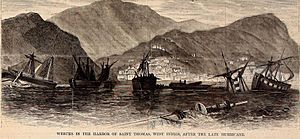1867 San Narciso hurricane facts for kids
| Category 3 major hurricane (SSHWS/NWS) | |

Storm path
|
|
| Formed | October 27, 1867 |
|---|---|
| Dissipated | October 31, 1867 |
| Highest winds | 1-minute sustained: 125 mph (205 km/h) |
| Lowest pressure | 952 mbar (hPa); 28.11 inHg |
| Fatalities | 811+ |
| Damage | $1 million (1867 USD) |
| Areas affected | Virgin Islands, Puerto Rico, Hispaniola |
| Part of the 1867 Atlantic hurricane season | |
The San Narciso Hurricane was a very powerful storm. It was the ninth and last big hurricane of the 1867 Atlantic hurricane season. This storm caused a lot of damage and sadly, many people lost their lives. It was the most expensive and deadliest storm that year. Over 811 people died, mostly in the Virgin Islands and Puerto Rico. The storm caused at least $1 million in damage in 1867 money.
Contents
How the Storm Formed
A tropical storm started to form around October 27, 1867. It was east of the northern Lesser Antilles, which are islands in the Caribbean Sea. A mail ship called Principe Alfonso was able to avoid the storm that day.
The storm moved west or southwest. It grew stronger and became a hurricane by October 28. On October 29, it became a major hurricane. This very strong storm hit an island called Sombrero, Anguilla. The winds there became very strong from 1 AM to 6 AM. For about half an hour, the air pressure dropped very low, and it was calm. Then, the wind became very strong again from the east until 11 AM. The hurricane was at its strongest near Sombrero island.
The Eye of the Storm
The center, or "eye," of the hurricane passed over Sankt Thomas (which was then part of the Danish West Indies) from 1:30 PM to 2:00 PM.
- Further information: Calendar of saints#Connection to tropical cyclones
The hurricane became a little weaker after leaving Saint Thomas. It then moved towards Puerto Rico later on October 29. This day was a special day for Saint Narcissus of Jerusalem. In Puerto Rico, hurricanes were often named after the saint of the day they hit. That is how this storm got its name, San Narciso.
The hurricane made landfall in Puerto Rico. Its winds became even weaker over the island. Even though it was not a very large storm, it was one of the strongest hurricanes ever recorded there. It passed near the city of Fajardo between 5 PM and 6 PM. Later, it passed near Caguas. People even felt the ground shake in towns like Humacao, Luquillo, and Peñuelas. The storm affected every town on the island of Puerto Rico.
The San Narciso Hurricane then hit the island of Hispaniola on October 30, 1867. The storm likely disappeared that same day over the high mountains of Hispaniola.
What Happened After the Storm
The hurricane caused at least 811 deaths in total. About 600 people died in Sankt Thomas (now part of the United States Virgin Islands). Another 211 people died in Puerto Rico.
Impact on the Virgin Islands
On Tortola in the British Virgin Islands, the storm was strongest from noon to 2 PM. It blew down one-third of the homes there. Twenty-two people died in Road Town. Two people died on Peter Island, and two more died on Westland (now called Soper's Hole).
On Saint Thomas, the hurricane pushed 80 ships onto the shore or wrecked them. This included a famous ship called the RMS Rhone. The air pressure dropped very low, and winds reached 74 miles per hour. Around 600 people drowned in Saint Thomas.
Impact on Puerto Rico
In Puerto Rico, 211 people died. The damage was estimated to be 13 million Spanish escudos. The hurricane destroyed the farms and crops on the island. This led to a very difficult economic time for Puerto Rico. The hurricane, along with other problems, made people very unhappy. This unhappiness contributed to a period of unrest on the island in 1868.
Impact on Hispaniola
The storm almost completely destroyed the city of Santo Domingo de Guzmán in the Dominican Republic. About 200 people died there on that day.


